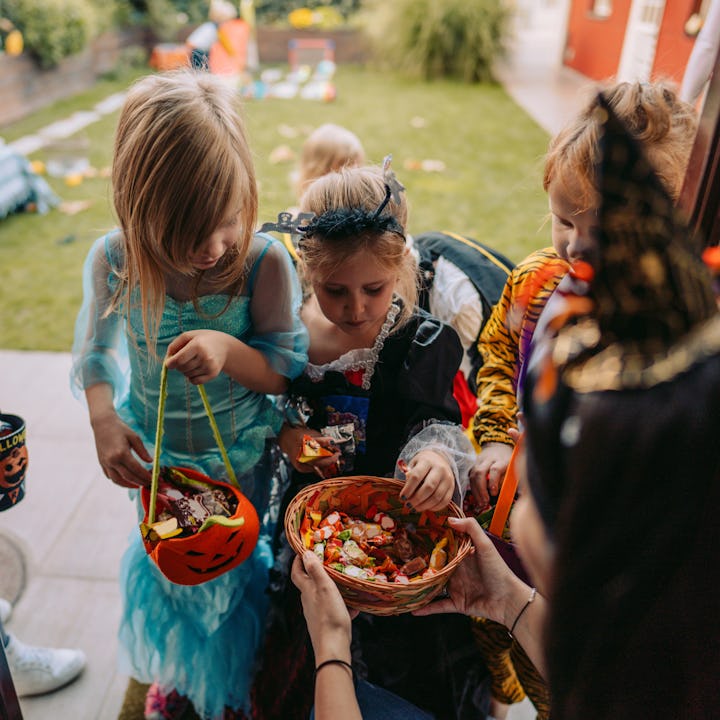The Actual Must-Follow Trick-Or-Treat Safety Tips, According To The AAP
Forget razor blades in candy. They just want you to use crosswalks.

“Don’t take homemade Halloween treats because they could have razor blades in them.” This little gem of a Halloween safety tip has actually been proven to be more of an urban legend than a real threat, but it’s top of parents’ minds nonetheless. Ahead of Halloween this year, the American Academy of Pediatrics has prepped a list of legit trick-or-treat safety tips for parents with kids of all ages. These pointers are based on real hazards and risks pediatricians know families encounter while they’re out getting their spook on.
Halloween isn’t dangerous because of evildoers lacing candy or shadowy figures lurking about. It’s just a combination of a lot of factors: Kids are out at dusk and night when it’s harder to see (and be seen). They’re excited and might be rushing around. Costumes can have long trains or floppy feet. When it all comes together, it just brings their risk of injury up a bit more than your average weeknight.
“Halloween can be a wonderfully festive time of year for children, families, and communities. But it’s also a time when children may be excited and walking outside in twilight or after dark,” said Dr. Deanna Behrens in a memo from the AAP. “Traffic, tripping hazards, and hard-to-spot costumes can become hazardous if precautions aren’t taken. We want everyone to have fun but also stay safe.”
Here’s what the AAP recommends parents do to keep kids of all ages safe while trick or treating:
- Pick a visible costume, or add lights to dark ones. Dark-colored costumes can make it difficult for drivers to see children crossing the road. Choosing a brightly colored costume goes a long way in making sure your little one is visible to motorists. If your kid picked a dark costume this year, you can increase their visibility by using a glow-in-the-dark treat pail or adding some small battery-powered lights to their bag or costume.
- Go trick-or-treating before dark. It’s safer to trick-or-treat while the sun is up and everyone can see well, obviously.
- Cross the street as a group in established crosswalks. Sixty-two percent of child pedestrian traffic fatalities happen mid-block rather than at intersections, according to the AAP. Teach your kids not to cross the street outside of designated crosswalks, from in between parked cars, or out of driveways or alleys.
- Choose a costume that fits well and is flame-resistant. If your kid is tripping over their Chewbacca feet or the train on their Elsa dress, see about making some adjustments to reduce their risk of tripping or getting hung up on something. Hats and wigs should fit properly so they don’t slide down and block your kid’s vision. There are also more pumpkins with candles inside and firepits around on Halloween, so while a flame-resistant costume might seem like safety overkill, it matters, the AAP says.
- Set your expectations with older kids before they head out. If your child is trick-or-treating without adults, make the rules clear. Only approach houses with their porch lights on. Bring flashlights and cross the street only where there is a designated crosswalk. Go over which route they’ll take and when they should return home.
- Food allergy parents should bring an EpiPen, just in case. Make sure to have an epinephrine auto-injector on hand and a charged phone to call 911 in an emergency. The AAP recommends not letting kids with food allergies nibble on candy while out and about. Instead, wait until you’re home, where you can thoroughly check their loot and toss out the risky pieces.
- Keep an eye out for choking hazards. The AAP says hard, sticky, or gooey candies, chewing gum, apple chunks, and popcorn should all be kept away from kids age 4 and under to prevent choking. Some houses give out small toys instead of candy, so be sure to take them out of your little one’s candy stash if they’ll fit in their mouth.
If your child has any specific health conditions, like a food allergy or epilepsy — which can be triggered in some people by strobe lights — talk to your pediatrician about how to address your specific concerns. And if you still don’t want to take homemade treats from anyone you don’t know, feel free to keep saying no thank you. A little extra caution never hurt anyone.